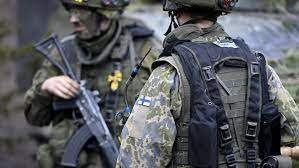NATO Arctic Exercises | NATO Launches Arctic Exercises, Pledges Protection of Finland
NATO, the North Atlantic Treaty Organization, has recently commenced a series of military exercises in the Arctic region. The exercises aim to enhance readiness and cooperation among NATO members and allied nations. The decision to conduct these maneuvers comes in response to the evolving security challenges in the Arctic region, including increasing geopolitical tensions and concerns over climate change impacts. This article provides an overview of the importance of this news, its historical context, and key takeaways for students preparing for government exams in various fields.

Why This News Is Important
The Arctic region has gained significant strategic importance in recent years due to the melting of polar ice, which has opened up new shipping routes and access to valuable natural resources. As the Arctic becomes more accessible, concerns over territorial disputes and potential security threats have escalated. By launching these exercises, NATO aims to demonstrate its commitment to safeguarding the security and stability of its member countries and their allies in the Arctic region.
For Finland, a non-NATO member, the Arctic exercises hold particular significance. Finland shares an 800-mile border with Russia, and tensions between Russia and NATO have increased in recent years. The exercises serve as a clear message of support and reassurance from NATO to Finland, affirming the alliance’s commitment to the country’s security and sovereignty. It also strengthens Finland’s position in the region and ensures its participation in collaborative efforts to address common security challenges.
The Arctic exercises provide an opportunity for NATO member states and their allies to enhance cooperation and interoperability. By conducting joint military drills and sharing best practices, participating countries can improve their readiness to respond effectively to potential threats in the Arctic. These exercises also foster greater understanding and coordination among the nations involved, which is crucial for maintaining regional stability and security.
Historical Context:
The Arctic region has witnessed significant transformations in recent years. With the melting of polar ice due to global warming, the region has become more accessible, attracting increased attention from nations worldwide. The potential for new shipping routes and the abundance of untapped natural resources have led to growing geopolitical competition and territorial disputes. As a result, nations with interests in the Arctic, including NATO member states, have been reevaluating their strategies and increasing their presence in the region.
Key Takeaways from “NATO Launches Arctic Exercises, Pledges Protection of Finland”:
| Takeaway | Key Takeaway |
|---|---|
| 1 | NATO has initiated a series of military exercises in the Arctic region to enhance readiness and cooperation among member states and allied nations. |
| 2 | The exercises aim to address emerging security challenges, including geopolitical tensions and concerns over climate change impacts in the Arctic. |
| 3 | For Finland, a non-NATO member, these exercises provide reassurance of NATO’s commitment to Finland’s security and sovereignty, particularly in light of its proximity to Russia. |
| 4 | The Arctic exercises foster cooperation and interoperability among participating nations, improving their readiness to respond to potential threats in the region. |
| 5 | In addition to security considerations, the exercises also emphasize the importance of addressing environmental and humanitarian challenges in the Arctic, such as climate change impacts and the well-being of coastal communities. |
Conclusion
The launch of NATO’s Arctic exercises and the commitment to protect Finland highlight the evolving security dynamics in the Arctic region. As the melting ice opens up new opportunities and challenges, NATO member states and their allies are actively working to strengthen cooperation, enhance readiness, and address environmental and humanitarian concerns.
For students preparing for government exams in various fields, understanding the importance of these exercises is crucial. It demonstrates the strategic significance of the Arctic region, the security implications for Finland, and the need for collaborative efforts to maintain stability and address climate change impacts.
Important FAQs for Students from this News
Q: What is NATO?
A: NATO stands for the North Atlantic Treaty Organization. It is an intergovernmental military alliance comprising 30 member countries, including the United States, Canada, and several European nations.
Q: Why is the Arctic region gaining strategic importance?
A: The Arctic region is gaining strategic importance due to the melting of polar ice, which has opened up new shipping routes and access to valuable natural resources. This has led to increased geopolitical competition and concerns over territorial disputes.
Q: Why is NATO conducting exercises in the Arctic?
A: NATO is conducting exercises in the Arctic to enhance readiness and cooperation among its member states and allied nations. The exercises aim to address emerging security challenges and demonstrate the alliance’s commitment to safeguarding the security and stability of its members in the region.
Q: What is the significance of these exercises for Finland?
A: The exercises hold particular significance for Finland as a non-NATO member with a border shared with Russia. They serve as a message of support and reassurance from NATO, affirming its commitment to Finland’s security and sovereignty in the face of increasing tensions in the region.
Q: Besides security, what other concerns are associated with the Arctic region?
A: In addition to security concerns, the Arctic region also faces environmental challenges due to climate change. The melting ice poses risks such as rising sea levels and the potential displacement of coastal communities. Addressing these environmental and humanitarian issues is an important aspect of NATO’s commitment to the region.
Some Important Current Affairs Links














